Journal of Southern Medical University ›› 2025, Vol. 45 ›› Issue (3): 494-505.doi: 10.12122/j.issn.1673-4254.2025.03.07
Yan HUANG1( ), Xi CHEN1, Mengchen QIN1, Lei GAO1,2,3(
), Xi CHEN1, Mengchen QIN1, Lei GAO1,2,3( )
)
Received:2024-11-20
Online:2025-03-20
Published:2025-03-28
Contact:
Lei GAO
E-mail:1197448288@qq.com;raygaolei@smu.edu.cn
Supported by:Yan HUANG, Xi CHEN, Mengchen QIN, Lei GAO. Core targets and immune regulatory mechanisms of Huoluo Xiaoling Pellet for promoting zebrafish fin regeneration[J]. Journal of Southern Medical University, 2025, 45(3): 494-505.
Add to citation manager EndNote|Ris|BibTeX
URL: https://www.j-smu.com/EN/10.12122/j.issn.1673-4254.2025.03.07
| Gene | Sequence of FP (5'-3') | Sequence of RP (5'-3') |
|---|---|---|
| Zf β-actin | ATGGATGAGGAAATCGCTGCC | CTCCTGATGTCTGGGTCGTC |
| Zf PCNA | TATGGACTCCTCTCATGTGTCTCTG | GTGATGATGTCTTCATTTCCAGCAC |
| Zf AKT1 | GATTACGGTCGTGCGGTGGA | TCCACCTAACCGCTGCATGG |
| Zf EGFR | GTGACCCGTCCCGCTATCTG | GTGGGGTCTGGGATGTAGCG |
| Zf STAT3 | AACGTGCAGCCCATTTTCGC | CCACGGAAACAAGCGCAGTC |
| Zf TLR4 | GACCGTGTTTGTTCGCTGCC | TTCAACTACAGCCCCACGGC |
| Zf NOS2 | CGGATCAGGAGGAGGATCGC | CGTGCTGCAAGTGCCGAAAT |
| Zf IL10 | CGCTTCTTCTTTGCGACTGTGCT | TCACCATATCCCGCTTGAGTTCC |
| Zf TNF-α | GCTGGATCTTCAAAGTCGGGTGTA | TGTGAGTCTCAGCACACTTCCATC |
| Zf TGF-β | GAACTCGCTTTGTCTCCA | TACAGTCGCAGTATAACCTCA |
| Zf IL-6 | CGGCATTTGAAGGGGTCAGGA | TGGCCTCCAGCAGTCGTTTG |
| Zf IL-1β | TGGACTTCGCAGCACAAAATG | CACTTCACGCTCTTGGATGA |
| Zf fgf20a | AAAAGCTGTCAGCCGAGTGT | TGGACGTCCCATCTTTGTTG |
| Zf msxb | ACACTTTGTCGAGCGTTTCGG | TCTTGTGCTTGCGTAAGGTGC |
| Zf IL4 | GGGATCCTGAATGGGAAAGGGG | AAGCCATTCCTGCTTGGCAGA |
| Zf IL13 | CTGGCCTGTCCGGTGTCAAAT | CTTCATCAGCAGCGTGACTCCT |
| Zf ARG1 | GGCCAGCCGATGTCTTACCT | GGGTCCAGCGCATCAATGTC |
| Zf ifng1 | GATGGGCTTTGCCTGGGGAG | TGCCAGCCTCTCCTTTGTAGC |
Tab.1 Primers used to quantify mRNA expression
| Gene | Sequence of FP (5'-3') | Sequence of RP (5'-3') |
|---|---|---|
| Zf β-actin | ATGGATGAGGAAATCGCTGCC | CTCCTGATGTCTGGGTCGTC |
| Zf PCNA | TATGGACTCCTCTCATGTGTCTCTG | GTGATGATGTCTTCATTTCCAGCAC |
| Zf AKT1 | GATTACGGTCGTGCGGTGGA | TCCACCTAACCGCTGCATGG |
| Zf EGFR | GTGACCCGTCCCGCTATCTG | GTGGGGTCTGGGATGTAGCG |
| Zf STAT3 | AACGTGCAGCCCATTTTCGC | CCACGGAAACAAGCGCAGTC |
| Zf TLR4 | GACCGTGTTTGTTCGCTGCC | TTCAACTACAGCCCCACGGC |
| Zf NOS2 | CGGATCAGGAGGAGGATCGC | CGTGCTGCAAGTGCCGAAAT |
| Zf IL10 | CGCTTCTTCTTTGCGACTGTGCT | TCACCATATCCCGCTTGAGTTCC |
| Zf TNF-α | GCTGGATCTTCAAAGTCGGGTGTA | TGTGAGTCTCAGCACACTTCCATC |
| Zf TGF-β | GAACTCGCTTTGTCTCCA | TACAGTCGCAGTATAACCTCA |
| Zf IL-6 | CGGCATTTGAAGGGGTCAGGA | TGGCCTCCAGCAGTCGTTTG |
| Zf IL-1β | TGGACTTCGCAGCACAAAATG | CACTTCACGCTCTTGGATGA |
| Zf fgf20a | AAAAGCTGTCAGCCGAGTGT | TGGACGTCCCATCTTTGTTG |
| Zf msxb | ACACTTTGTCGAGCGTTTCGG | TCTTGTGCTTGCGTAAGGTGC |
| Zf IL4 | GGGATCCTGAATGGGAAAGGGG | AAGCCATTCCTGCTTGGCAGA |
| Zf IL13 | CTGGCCTGTCCGGTGTCAAAT | CTTCATCAGCAGCGTGACTCCT |
| Zf ARG1 | GGCCAGCCGATGTCTTACCT | GGGTCCAGCGCATCAATGTC |
| Zf ifng1 | GATGGGCTTTGCCTGGGGAG | TGCCAGCCTCTCCTTTGTAGC |
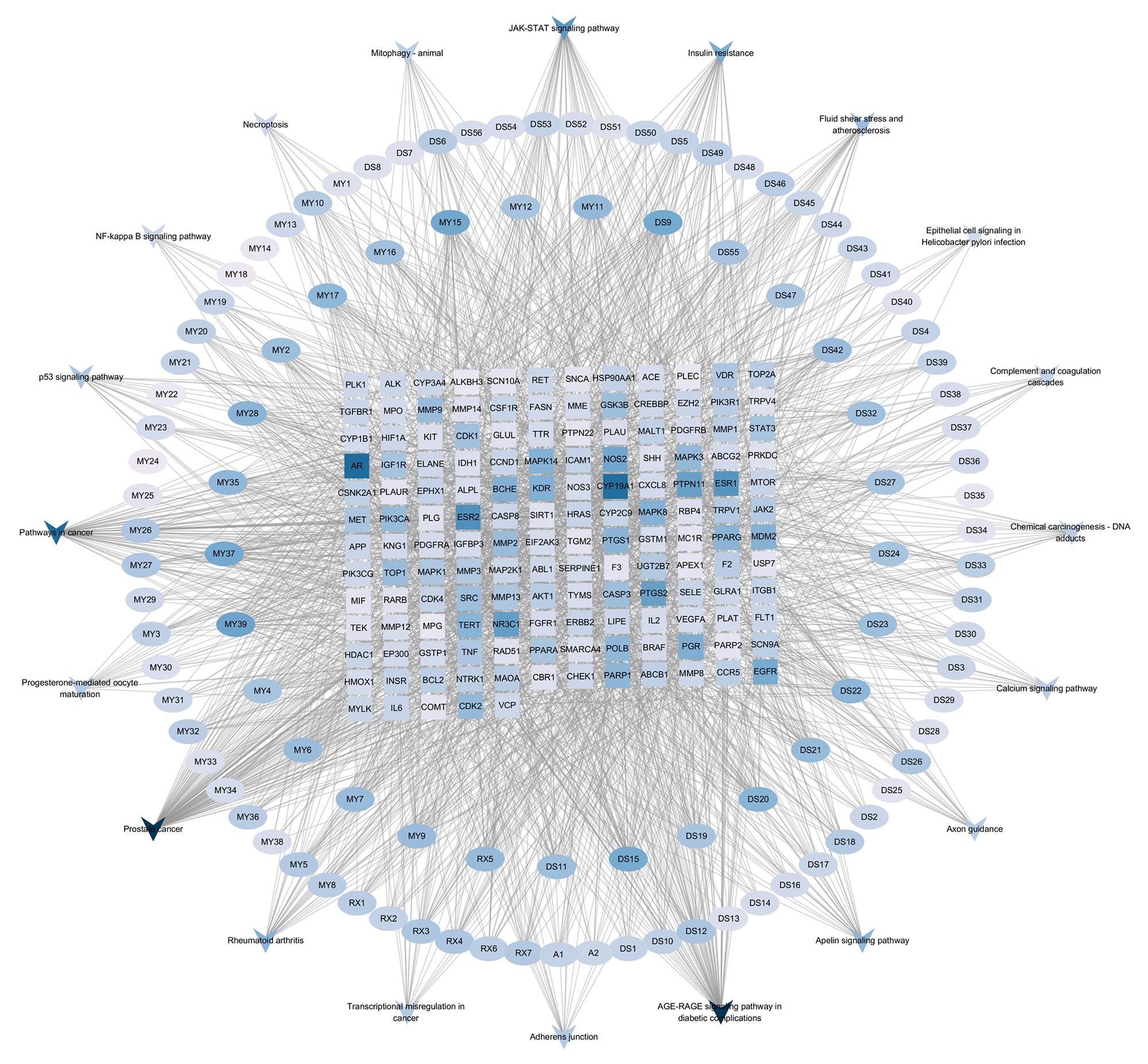
Fig.4 "Active ingredient-target-signaling pathway" network of Huoluo Xiaoling Pellet for promoting tissue repair. Elliptical markers represent active ingredients, rectangular markers represent the targets, and inverted triangle markers represent the signaling pathways. DG, DS, RX, and MY denote Danggui, Danshen, Ruxiang, and Moyao, respectively.
| Number | Mol ID | Active ingredient | Degree | Betweenness centrality | Closeness centrality |
|---|---|---|---|---|---|
| MY39 | MOL000490 | petunidin | 37 | 0.02587001 | 0.4317817 |
| MY15 | MOL001033 | diayangambin | 36 | 0.02263804 | 0.42630745 |
| DS9 | MOL000006 | luteolin | 35 | 0.01654172 | 0.42902711 |
| MY37 | MOL001164 | [(5S, 6R, 8R, 9Z)-8-methoxy-3, 6, 10-trimethyl-4-oxo-6, 7, 8, 11-tetrahydro-5H-cyclodeca[b]furan-5-yl] acetate | 35 | 0.01612 | 0.42630745 |
| DS15 | MOL007049 | 4-methylenemiltirone | 34 | 0.01770958 | 0.42362205 |
| DS20 | MOL007061 | methylenetanshinquinone | 29 | 0.01130007 | 0.41965679 |
| MY28 | MOL001095 | isofouquierone | 29 | 0.0106332 | 0.40573152 |
| DS22 | MOL007064 | przewalskin b | 28 | 0.00999823 | 0.41194487 |
| MY17 | MOL001045 | (13E, 17E, 21E)-8-hydroxypolypodo-13, 17, 21-trien-3-one | 27 | 0.01052943 | 0.40943683 |
| MY35 | MOL001148 | 3β-hydroxydammar-24-ene | 27 | 0.00947679 | 0.41194487 |
Tab.2 Top 10 active ingredients in Huoluo Xiaoling Pellet
| Number | Mol ID | Active ingredient | Degree | Betweenness centrality | Closeness centrality |
|---|---|---|---|---|---|
| MY39 | MOL000490 | petunidin | 37 | 0.02587001 | 0.4317817 |
| MY15 | MOL001033 | diayangambin | 36 | 0.02263804 | 0.42630745 |
| DS9 | MOL000006 | luteolin | 35 | 0.01654172 | 0.42902711 |
| MY37 | MOL001164 | [(5S, 6R, 8R, 9Z)-8-methoxy-3, 6, 10-trimethyl-4-oxo-6, 7, 8, 11-tetrahydro-5H-cyclodeca[b]furan-5-yl] acetate | 35 | 0.01612 | 0.42630745 |
| DS15 | MOL007049 | 4-methylenemiltirone | 34 | 0.01770958 | 0.42362205 |
| DS20 | MOL007061 | methylenetanshinquinone | 29 | 0.01130007 | 0.41965679 |
| MY28 | MOL001095 | isofouquierone | 29 | 0.0106332 | 0.40573152 |
| DS22 | MOL007064 | przewalskin b | 28 | 0.00999823 | 0.41194487 |
| MY17 | MOL001045 | (13E, 17E, 21E)-8-hydroxypolypodo-13, 17, 21-trien-3-one | 27 | 0.01052943 | 0.40943683 |
| MY35 | MOL001148 | 3β-hydroxydammar-24-ene | 27 | 0.00947679 | 0.41194487 |
| Active ingredient | AKT1 | IL6 | TNF | EGFR | STAT3 |
|---|---|---|---|---|---|
| Petunidin | -8.945 | -5.695 | -8.657 | -6.666 | -5.256 |
| Diayangambin | -9.256 | -4.711 | -6.801 | -6.224 | -4.331 |
| Luteolin | -9.539 | -6.244 | -8.509 | -7.556 | -5.601 |
[(5S, 6R, 8R, 9Z)-8-methoxy-3, 6, 10-trimethyl-4-oxo-6, 7, 8, 11- tetrahydro-5H-cyclodeca[b]furan-5-yl] acetate | -8.202 | -5.165 | -7.881 | -6.628 | -4.732 |
| 4-methylenemiltirone | -10.652 | -6.558 | -8.393 | -8.194 | -5.372 |
Tab.3 Molecular docking binding energy prediction
| Active ingredient | AKT1 | IL6 | TNF | EGFR | STAT3 |
|---|---|---|---|---|---|
| Petunidin | -8.945 | -5.695 | -8.657 | -6.666 | -5.256 |
| Diayangambin | -9.256 | -4.711 | -6.801 | -6.224 | -4.331 |
| Luteolin | -9.539 | -6.244 | -8.509 | -7.556 | -5.601 |
[(5S, 6R, 8R, 9Z)-8-methoxy-3, 6, 10-trimethyl-4-oxo-6, 7, 8, 11- tetrahydro-5H-cyclodeca[b]furan-5-yl] acetate | -8.202 | -5.165 | -7.881 | -6.628 | -4.732 |
| 4-methylenemiltirone | -10.652 | -6.558 | -8.393 | -8.194 | -5.372 |
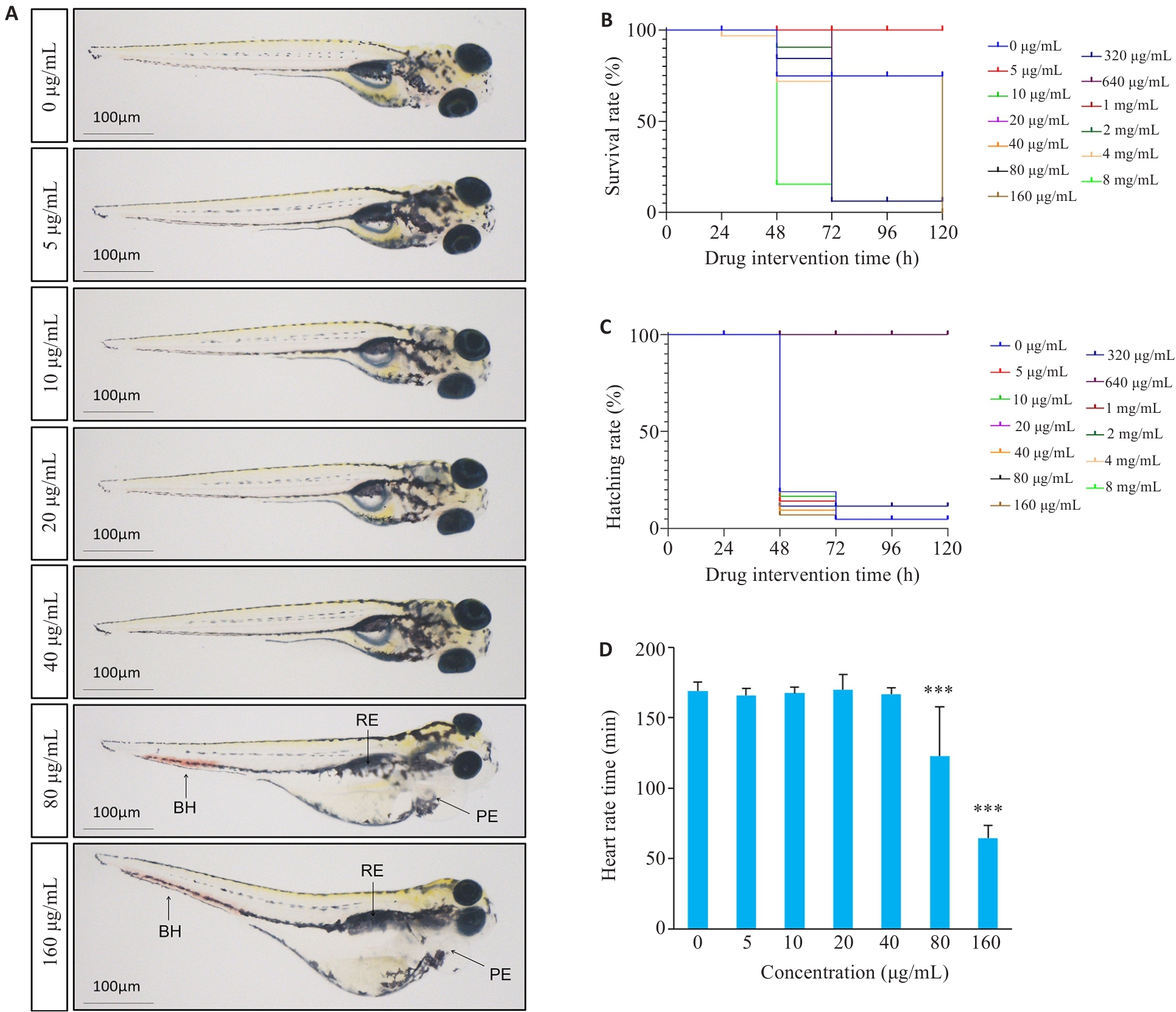
Fig.5 Toxic effects of Huoluo Xiaoling Pellet extract on zebrafish larvae (Mean±SD, n=30). A: Effect of Huoluo Xiaoling Pellet extract on zebrafish larvae growth and development (VD: Vasodilation; RE: Renal edema; PE: Pericardial edema). B: Survival rate. C: Hatching rate. D: Heart rate. ***P<0.001 vs 0 μg/mL group.
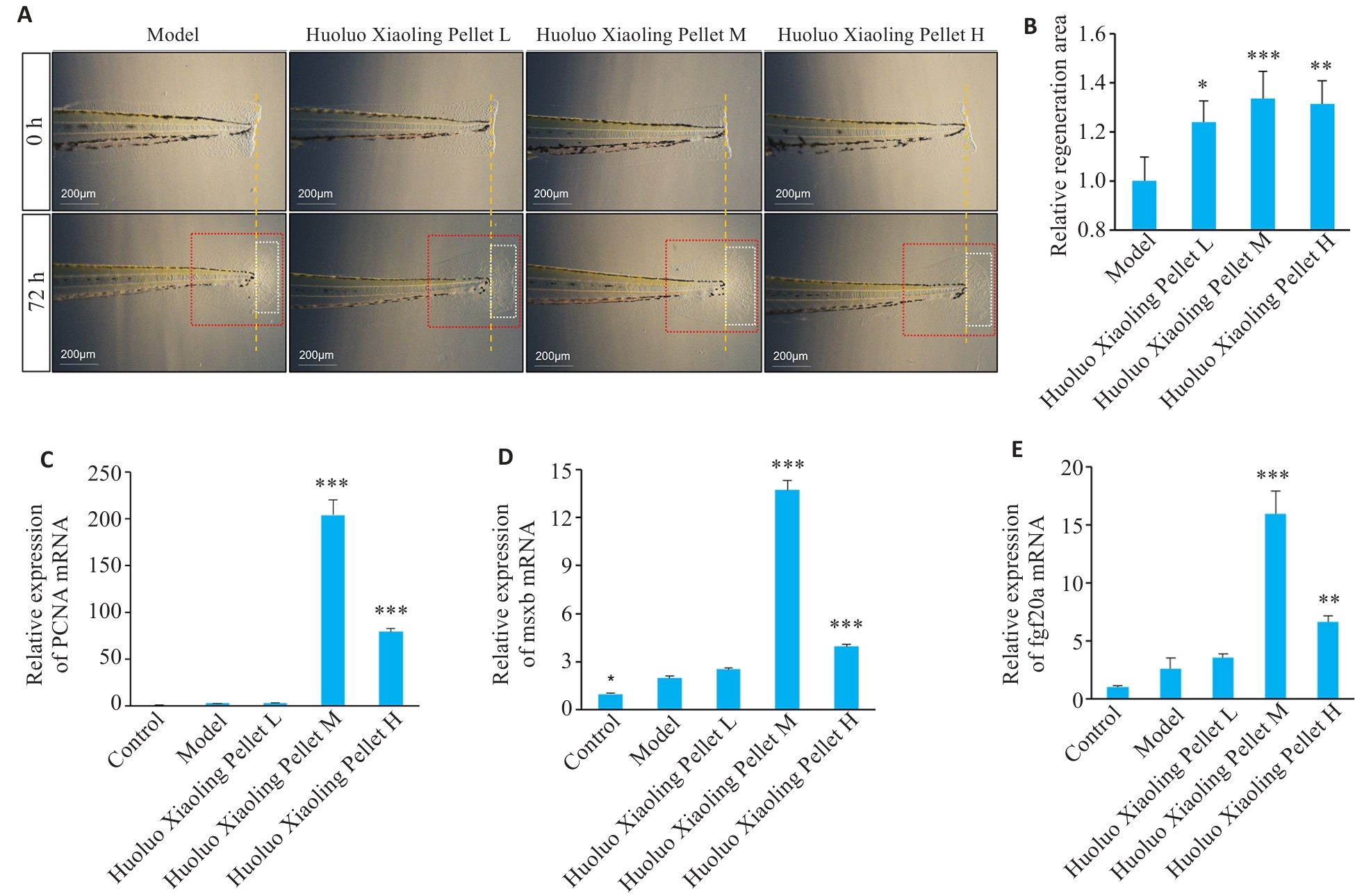
Fig.6 Effect of different concentrations of Huoluo Xiaoling Pellet extract on tail fin tissue defect repair in the zebrafish. A: Changes in tail fin defect of the zebrafish after treatment with formulated medium (model group) and low-, medium-, and high-dose Huoluo Xiaoling Pellet extract. B: Relative area of tail fin tissue repair measured 72 h post-surgery in different groups (Mean±SD, n=4). C-E: Expression levels of PCNA, msxb and fgf20a mRNA in zebrafish 72 h after tail fin amputation (Mean±SD, n=3). *P<0.05, **P<0.01, ***P<0.001 vs Model group.
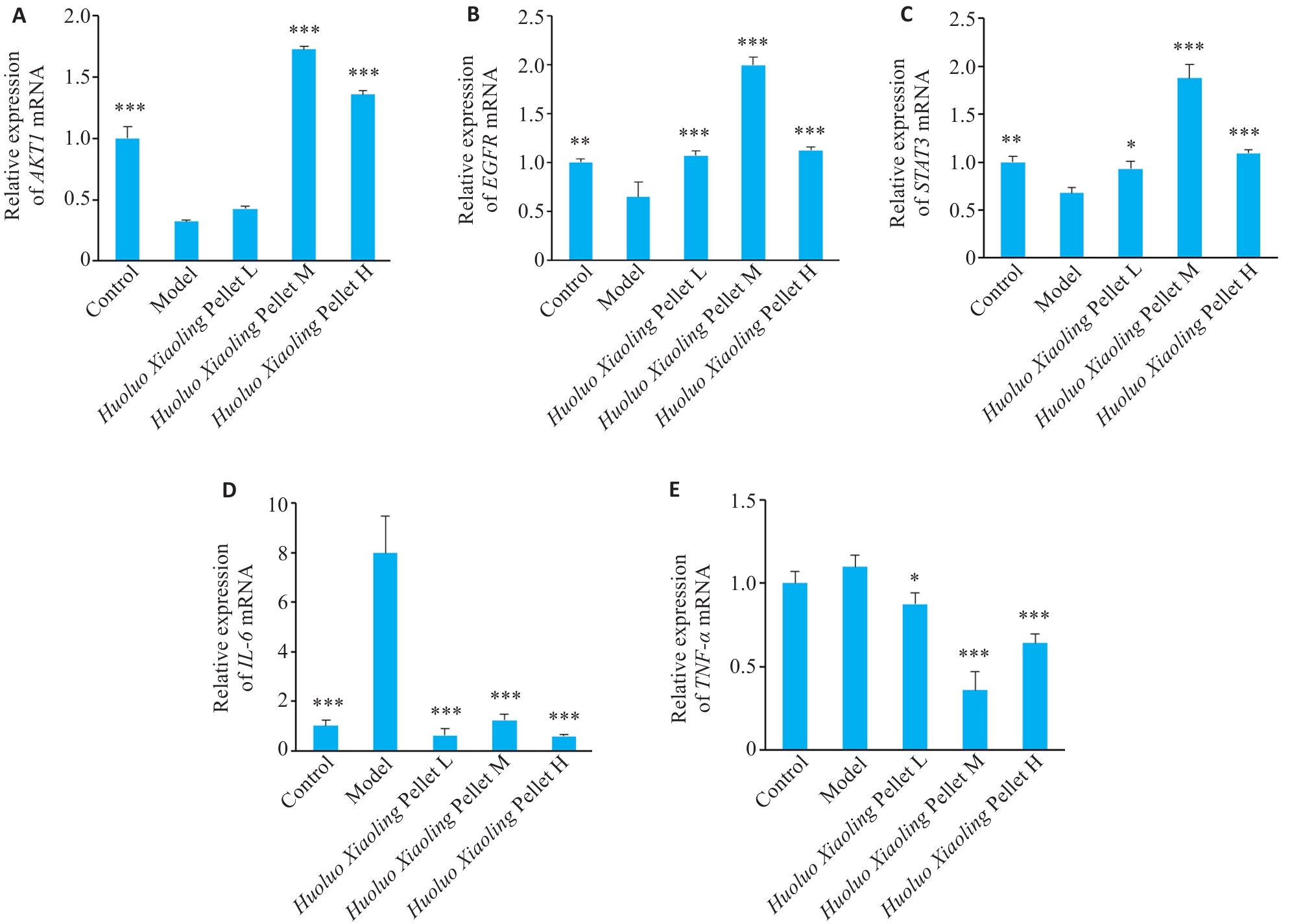
Fig.7 Effect of different concentrations of Huoluo Xiaoling Pellet extract on expressions of the core targets related to tail fin repair in zebrafish (Mean±SD, n=3). A-E: The mRNA expression levels of AKT1, EGFR, STAT3, IL-6, and TNF-α in zebrafish 72 h after tail fin amputation. *P<0.05, **P<0.01, ***P<0.001 vs Model group.

Fig.8 Huoluo Xiaoling Pellet regulates migration of macrophages and neutrophils in the wound of zebrafish tail fin (Mean±SD, n=3). A, B: Distribution of macrophages and neutrophils at the injury site of the tail fin of zebrafish at 24 h and 48 h. C, D: Statistical analysis of macrophage and neutrophil migration to the tissue repair site at 24 h and 48 h. E: The mRNA expression levels of ifng1 in zebrafish detected by qPCR. *P<0.05, **P<0.01, ***P<0.001 vs Model group; #P<0.05 vs 48 h Model group.
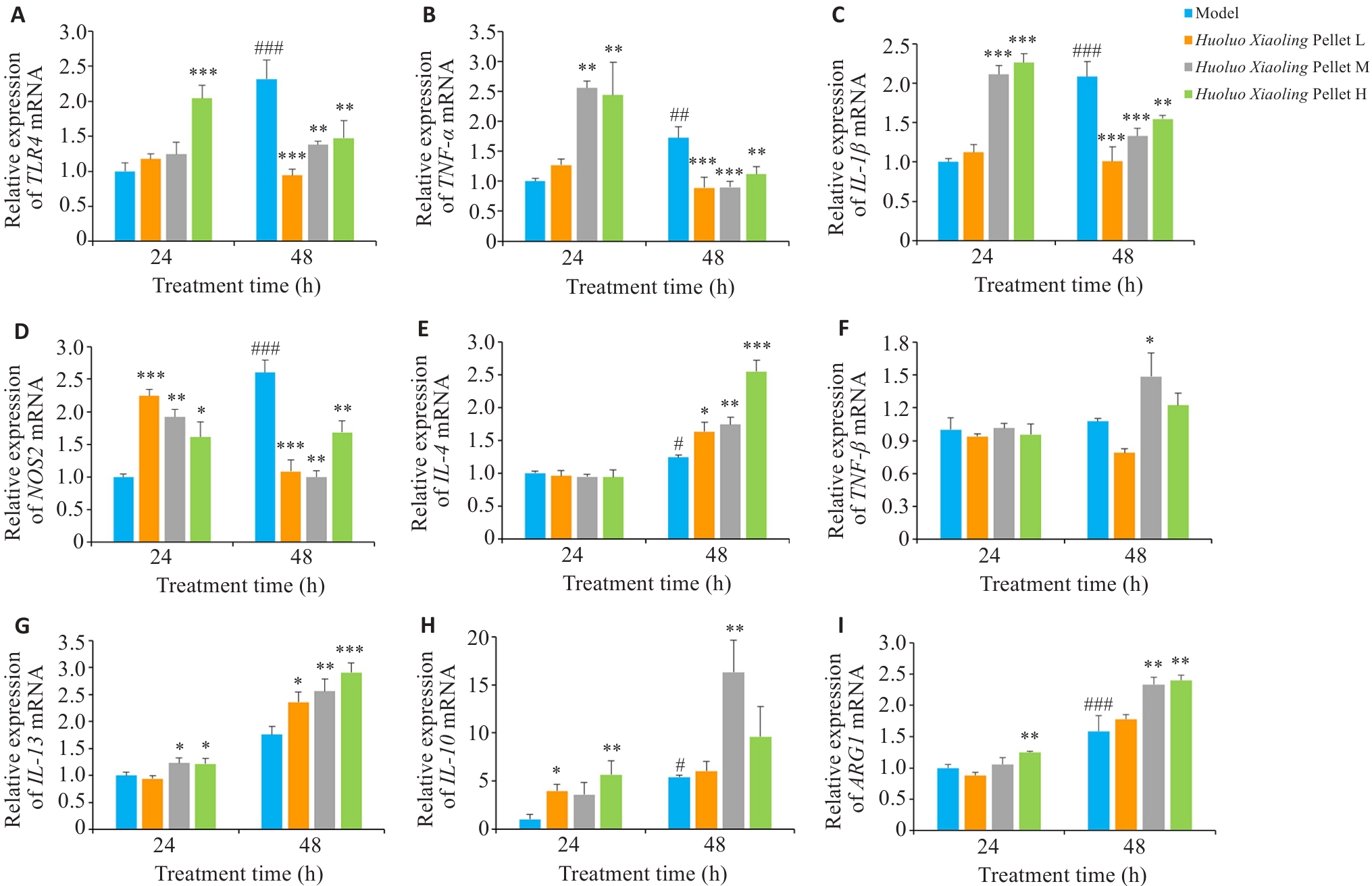
Fig.9 Huoluo Xiaoling Pellet regulates expressions of macrophage subset markers at different stages of tissue regeneration (Mean±SD, n=3). A-I: The mRNA expression levels of TLR4, TNF-α, IL-1β, NOS2, IL-4, TGF-β, IL-13, IL-10 and ARG1 in zebrafish detected by qPCR. *P<0.05, **P<0.01, ***P<0.001 vs Model group; #P<0.05, ##P<0.01, ###P<0.001 vs 48 h Model group.
| 1 | Xiong Y, Mi BB, Lin Z, et al. The role of the immune microenvironment in bone, cartilage, and soft tissue regeneration: from mechanism to therapeutic opportunity[J]. Mil Med Res, 2022, 9(1): 65. |
| 2 | Eming SA, Martin P, Tomic-Canic M. Wound repair and regeneration: mechanisms, signaling, and translation[J]. Sci Transl Med, 2014, 6(265): 265sr6. |
| 3 | Gurtner GC, Werner S, Barrandon Y, et al. Wound repair and regeneration[J]. Nature, 2008, 453(7193): 314-21. |
| 4 | Mosser DM, Edwards JP. Exploring the full spectrum of macrophage activation[J]. Nat Rev Immunol, 2008, 8(12): 958-69. |
| 5 | (明)王肯堂. 证治准绳-四-疡医: 六卷[M]. 上海卫生出版社, 1958. |
| 6 | 鄢红玉, 万 飞, 郭剑华, 等. 活络效灵丹加减方对大鼠急性软组织损伤的保护作用及机制初探[J]. 重庆医学, 2019, 48(16): 2737-42. |
| 7 | 徐英姿, 韩向东. 关于活络效灵丹的浅析[J]. 四川中医, 2014, 32(9): 28-30. |
| 8 | 孔令钧. 血瘀证患者与细胞粘附分子表达的关系[J]. 山东大学学报: 医学版, 2004, 42(3): 346-8. |
| 9 | 廖奕华, 艾 陵, 张道亮, 等. 冠心病血瘀证患者免疫功能的初步研究[J]. 辽宁中医杂志, 1998, 25(2): 58-9. |
| 10 | Zhang P, Zhang DF, Zhou WA, et al. Network pharmacology: towards the artificial intelligence-based precision traditional Chinese medicine[J]. Brief Bioinform, 2023, 25(1): bbad518. |
| 11 | Marques IJ, Lupi E, Mercader N. Model systems for regeneration: zebrafish[J]. Development, 2019, 146(18): dev167692. |
| 12 | Howe K, Clark MD, Torroja CF, et al. The zebrafish reference genome sequence and its relationship to the human genome[J]. Nature, 2013, 496(7446): 498-503. |
| 13 | 陈家奎. slc20a1b调控斑马鱼造血干祖细胞的功能研究及机制初探[D]. 广州: 南方医科大学, 2021. |
| 14 | 王和鸣. 中医伤科学[M]. 北京: 中国中医药出版社, 2002. |
| 15 | 清)吴 谦. 医宗金鉴: 九十卷[M]. 北京: 人民卫生出版社, 1963. |
| 16 | 吴虓飞, 高晓新, 高 阳, 等. 活络效灵丹颗粒对大鼠的长期毒性试验研究[J]. 药物评价研究, 2016, 39(6): 973-82. |
| 17 | Whitehead GG, Makino S, Lien CL, et al. fgf20 is essential for initiating zebrafish fin regeneration[J]. Science, 2005, 310(5756): 1957-60. |
| 18 | Thummel R, Enright JM, Kassen SC, et al. Pax6a and Pax6b are required at different points in neuronal progenitor cell proliferation during zebrafish photoreceptor regeneration[J]. Exp Eye Res, 2010, 90(5): 572-82. |
| 19 | Sigismund S, Avanzato D, Lanzetti L. Emerging functions of the EGFR in cancer[J]. Mol Oncol, 2018, 12(1): 3-20. |
| 20 | 曾鸿孟. MEBT/MEBO对大鼠难愈合创面中PTEN/AKT/VEGF信号系统表达的影响[D]. 南宁: 广西中医药大学, 2017. |
| 21 | Sun JC, Zhao HQ, Shen CA, et al. Tideglusib promotes wound healing in aged skin by activating PI3K/Akt pathway[J]. Stem Cell Res Ther, 2022, 13(1): 269. |
| 22 | Liu JF, Guo S, Jiang KF, et al. miR-488 mediates negative regulation of the AKT/NF‑κB pathway by targeting Rac1 in LPS-induced inflammation[J]. J Cell Physiol, 2020, 235(5): 4766-77. |
| 23 | Sano S, Itami S, Takeda K, et al. Keratinocyte-specific ablation of Stat3 exhibits impaired skin remodeling, but does not affect skin morphogenesis[J]. EMBO J, 1999, 18(17): 4657-68. |
| 24 | Bouchery T, Harris N. Neutrophil-macrophage cooperation and its impact on tissue repair[J]. Immunol Cell Biol, 2019, 97(3): 289-98. |
| 25 | Qin MC, Ou RX, He WY, et al. Salvianolic acid B enhances tissue repair and regeneration by regulating immune cell migration and Caveolin-1-mediated blastema formation in zebrafish[J]. Phytomedicine, 2024, 130: 155553. |
| 26 | Wynn TA, Vannella KM. Macrophages in tissue repair, regeneration, and fibrosis[J]. Immunity, 2016, 44(3): 450-62. |
| 27 | Yaghi OK, Hanna BS, Kent Langston P, et al. A discrete 'early-responder' stromal-cell subtype orchestrates immunocyte recruitment to injured tissue[J]. Nat Immunol, 2023, 24(12): 2053-67. |
| 28 | Lohmann N, Schirmer L, Atallah P, et al. Glycosaminoglycan-based hydrogels capture inflammatory chemokines and rescue defective wound healing in mice[J]. Sci Transl Med, 2017, 9(386): eaai9044. |
| 29 | Gocher AM, Workman CJ, Vignali DAA. Interferon-γ: teammate or opponent in the tumour microenvironment[J]? Nat Rev Immunol, 2022, 22(3): 158-72. |
| 30 | Mantovani A, Sica A, Locati M. Macrophage polarization comes of age[J]. Immunity, 2005, 23(4): 344-6. |
| 31 | Mantovani A, Biswas SK, Galdiero MR, et al. Macrophage plasticity and polarization in tissue repair and remodelling[J]. J Pathol, 2013, 229(2): 176-85. |
| Viewed | ||||||
|
Full text |
|
|||||
|
Abstract |
|
|||||